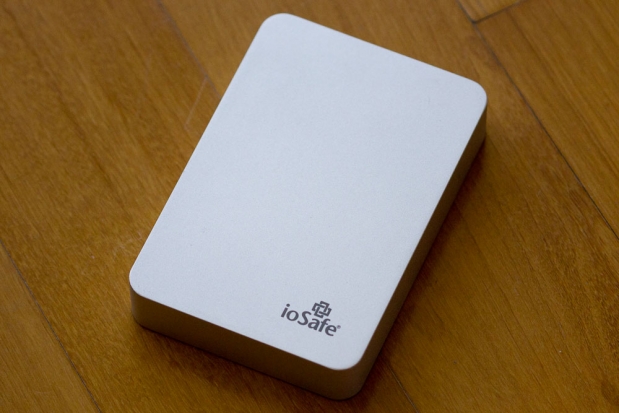
Carved out of Aluminium, it doesn't get much more solid than this.
It's no secret that I care a lot about keeping my photos safe, whether I'm at home or out and about.
As a photographer, you often end up trekking three quarters of the way around the world to get some photographs. By its very nature, this journeying tends to make the photos unrepeatable - so how would you go about ensuring that your valuable photographs don't go missing? The two above articles show a pretty good workflow, but when my girlfriend recently dropped a backup drive on the floor, leaving it useless, I was thinking: Perhaps there's another aspect to travel that I hadn't thought about quite enough yet: Your equipment goes through an awful lot of abuse. Perhaps upgrading to some more sturdy harddrives would be a good idea? Preferably something that's completely shock- and water proof?
And so the hunt began. After some googling, I found a company called ioSafe, who make a series of external hard drives that are specifically designed to withstand a seriously abusive relationship. How serious? well, that's the bit I was going to find out...
I procured one of their Rugged Portable drives with FireWire 800 connectivity (it also has USB 3.0, but since my MacBook only has USB 2.0, I didn't bother testing this), and decided to give it a proper test.
Test 1 - shock absorption
To start off, I dropped the harddrive off a table onto a wooden floor a couple of times. This thing is so solidly built that it did dent the floor, but the drive itself escaped without a flash. So I started thinking up more cruel ways of treating the drive.
... And then I came up with the ultimate test. I had a journey from London to Buenos Aires coming up. What better way to test whether a drive is solid enough, than to... Put it in the top pocket of my backpack. I should add, at this point, that my backpack is a great travel tool, but the top pocket has no protection whatsoever: It's a thin material, and it is as close to just using zip-ties to affixing the drive to my suitcase as I dared to go.
So, the drive passed through several set of X-ray machines, and was manhandled by luggage crews both at Heathrow's terminal 5 and Buenos Aires international airport. In fact, when I asked the team at ioSafe whether they thought this would be a good test, their PR boss got back to me and said "In your luggage? Unpadded and unprotected? Heck, you certainly don't pull any punches. What next? Trial by toddler? :-)"
Nonetheless, the drive passed with flying colours: Not a scratch, not a dent, and when I plugged it in, it happily whirred back to life, without skipping a beat.
Verdict: Pass.
Test 2 - Flooding
My second test was, if possible, even worse. I've drowned enough electronics in my life that I know that, generally, when something gets wet, it's game over. When I'm travelling, I protect my backup drive my putting it in a Ziploc bag (I ought to use one of these, really...), but this drive claims to be fully water proof for up to 3 days.
Now, I'm an avid Scuba diver (in fact, I'm a licenced PADI Divemaster), and if I had any dives coming up, I'd have taken the drive down to 40 meters (130 ft) to test it. Sadly, I'm currently in Buenos Aires, and there's not a lot of diving to be done 'round here, so I figured I'd try the next best thing: Leaving the drive in my sink for a little while.
I did a little video of this particular part of the experiment:
Verdict: Pass!
Conclusion
The FireWire 800 drive is bloody quick, and the drive passed both my rounds of torture. Suffice to say that I'd be more than happy to trust the ioSafe Rugged drives with my vital data. If you want to be extra double-plus safe, you could even consider getting the SSD (solid state drive) edition, rather than the Harddrive version. It's more expensive (you can get a 600GB SSD version with a titanium enclosure, but it'll set you back a hefty $3,000), but basing your backups on SSDs makes sense: SSDs have no moveable parts, which makes them even less susceptible to damage if you decide to, say, drop them out of a moving car or similar.
As ever, even with nigh-on bulletproof and water-defying drives, it's a good idea to be as careful as you can with them. The huge difference with these particular drives, then, is that you increase your margins of error drastically.
Highly recommended for photographers on the go who can't afford to leave the integrity of their data to chance!





